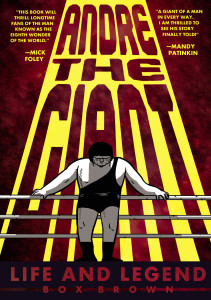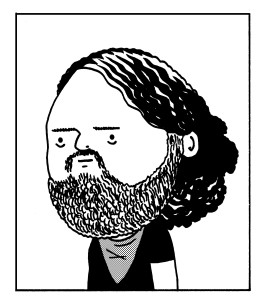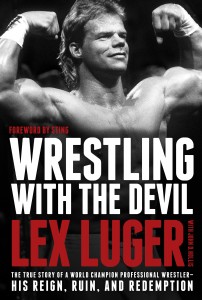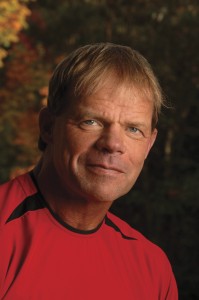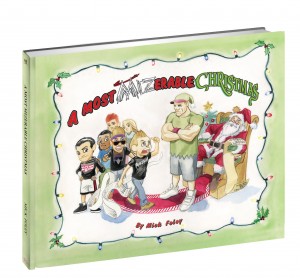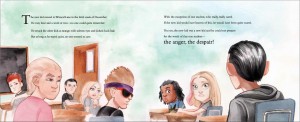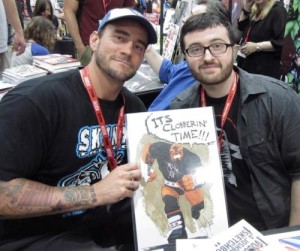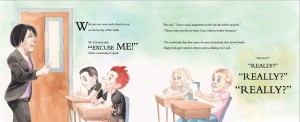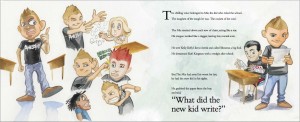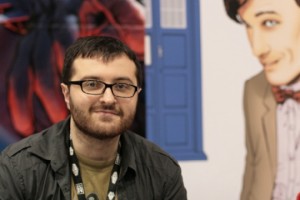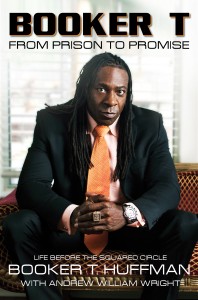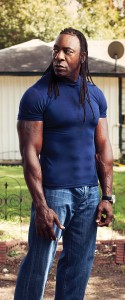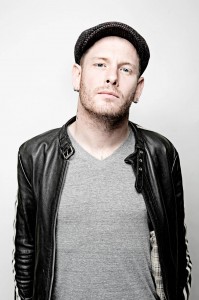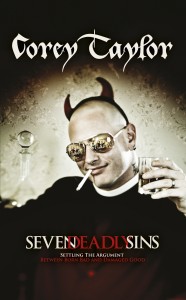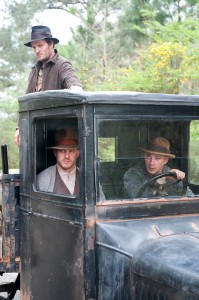
Howard (Jason Clarke), Forrest (Tom Hardy) and Jack (Shia LaBeouf) are the immortal Bondurant Boys in "Lawless"
When one uncovers some dark secret from his family’s past, the common inclination is to want to find out more. Even if the people involved were long gone before you were born, there’s still a sense that the actions of these people so many years ago might help define who you are today. Just as the new Southern bootleg film Lawless is derived from Matt Bondurant‘s 2008 novel The Wettest County in the World, Bondurant himself has created a story rooted in historical events involving his grandfather Jack and uncles Forrest and Howard. These Bondurant Brothers were the stuff of legend in Franklin County, Va. for staving off authorities to create a thriving moonshine business during the Prohibition. While Lawless graphically recounts the conniving violence and brutality that naturally came along with such successful criminal activities, it also delves into the nuances of the personal struggles of everyone involved. As his fictional portrayal of his family’s own part in bootlegging business hits theaters today (with Shia LaBeouf playing the author’s grandfather), Matt talks to Wrestling with Pop Culture about the differences between the novel and the film, the research that went into his book and how it feels to have discovered these notorious tales that preceded him.
At what point did you realize that this story needed to be told?
I had a general sense that my grandfather was involved in moonshine when I was younger, but it wasn’t something we discussed within the family. It wasn’t until 15 years ago, when my father started doing some research and uncovered some newspaper articles and showed them to me. We came across this article describing this incident at a place called the Maggodee Creek Bridge in December of 1930, which is the climactic scene in the film. The news version described my grandfather Jack and his two brothers as the Bondurant Boys. Some of the things that were said there made it clear they weren’t just simple moonshiners, they were a known entity that was somewhat notorious. This was a revelation to my father and me, so I wanted to know more about this. I was intrigued about it for the family story aspect, it seemed cool. It wasn’t until I published my first novel in 2005, The Third Translation, that I had the confidence to attack a project like this.
In the early stages I was thinking of it as a non-fiction piece, but it became clear that there wasn’t enough material to work with. There’s no diaries or letters and very little to account for these men’s lives day to day, month to month or year to year. Around 2004, I decided I was going to do a novelization. So I took what information I did have and worked a dramatic narrative to connect it.
Why did you decide to use Jack as your focal point?
He’s kind of the most transformative figure. Maybe it’s because he was my grandfather and is closest to me, and I knew my grandfather as a young boy. From what we do know, Forrest was clearly the acknowledged leader of the group and was a tough character. Jack was the one that seemed like the most obvious transformative figure that I think the reader would more closely align themselves with as somebody who’s trying to enter into this world and these activities with his brothers. He’s also the one who is striving to change himself and his situation. He wants to get out, he has bigger dreams of other things, so I think that’s naturally who the reader would gravitate towards. It may be because he’s the youngest I just felt closer to him in some way.
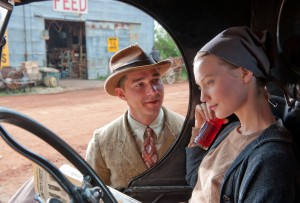
Jack (Shia LaBeouf) awkwardly woos Bertha (Mia Wasikowska) in "Lawless"
In the book, Sherwood Anderson, who is not in the movie at all, gets a lot of time. And I think in the book the three brothers get closer to equal treatment. Howard gets hardly any time at all in the movie, but in the book there’s a whole thing with Howard and his backstory, his wife and all the things going on in Howard’s life. There’s a bit more with Forrest and Maggie in the book as well, which was unfortunately shortened in the film. I know there are some scenes with Howard that were cut out of the film just for time. So I think that emphasis is more pointed in the film than the book.
Speaking of the differences between the book and the film, Nick Cave wrote the screenplay for the movie. Did he ask you for input at all?
No, he didn’t. At the press conference from Cannes, somebody asked him that directly and his answer was, “Nope.” But I understand it totally because my vision is there in black and white. He needed to take that and come up with his own vision for it, so consulting with me would be like me getting my stuff in there again. If I was in his shoes, I wouldn’t have consulted with the author either because everything that I have to say is in the book. The way that I think anything should be done with the story is in the book, so he could come up with his own take on it and to include me might be kind of strange. I have great respect for him and I think he did a good job with the script. I saw a couple of different iterations of the script about a year before the movie was made and I could tell he had condensed things in a way that made sense, which is a difficult process, and had some sharp scenes in there. The way he adapted some of the scenes in the book, I thought he did a good job. I’ve read one of his novels and he’s a good writer. I was kind of surprised to find out he wrote screenplays, but then it kind of makes sense if you listen to his lyrics.
What was the process of bringing your story to life as a film like for you?
Most of it was happening at a great distance. Agents were doing things in L.A. and New York and they were notifying me of things occasionally. When we sold the rights for the film to Columbia Pictures, that was a pretty big deal and I just happened to be in New York at the time with my agent having dinner with my wife. He actually concluded the deal over the phone while we were having dinner. You don’t really think that someone’s going to make the film because lots of rights get sold all the time and I know lots of writers who have had film rights bought and it just doesn’t get made. Very quickly, though, [director John] Hillcoat, Cave and Shia were attached. My understanding of it is that the three of them were the ones who liked it from the very beginning and were the ones who caused the producers to buy it.
We sold it in 2008, then there was a strange period in 2010 when all these other actors started becoming attached to it. I knew none of it means anything until somebody puts money down and they start building a set. Then in 2011 everything fell into place really quickly, and I think a lot of that had to do with Tom Hardy becoming involved. I think everybody wanted to work with John Hillcoat and they really wanted to work with Nick Cave, they thought the screenplay was good, and Shia, of course, is interesting and is a draw. But it’s a mid-to-low budget indie film and the funding was weird for a while. When they finally went to green light it into production, they said Tom Hardy was on board and all of a sudden everybody else just piled on there. Then Jessica Chastain gets in there and everybody wants to work with her, and Gary Oldman, and everybody was trying to get in.
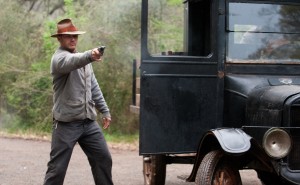
Forrest (Tom Hardy) is the unkillable leader of the Bondurant Brothers in "Lawless"
Then they started production and they did invite me down to the set, so my dad and I came down for a couple of days. The producers kept me really involved, Hillcoat called me and we had several phone conversations and email exchanges, some of the actors called me and emailed me, and they did, out of their own generosity, keep me involved quite a bit. They didn’t have to, there was no contractual obligation, but they consulted with me on a few points for accuracy. They wanted to stay true to the spirit of the book and maintain the spirit of the characters, and to some small degree they wanted me to be happy with the product. They weren’t setting out to please me, but maybe my opinion mattered just a tiny bit.
Were there any scenes from the book you would have liked to have seen in the movie that were omitted?
The film doesn’t really go into the background of Howard [Jason Clarke] and how he came to be the way he is. That’s not a fault of the film, I’m just saying that that kind of character development is difficult to do. There are a lot of scenes with Howard and his wife exploring his impulsiveness, his drinking problem and he has kind of a rage issue. That comes from his experiences in World War I, which is not in the film at all.
The film opens up with the same scene that the book opens with, which is a pig slaughtering scene, although it’s done slightly different in the book. Forrest actually straddles the pig and cuts its throat, which is what you’d normally do. It’s a really bloody, gory sort of scene and Hillcoat told me they tried to do that with a pig cadaver, but they just couldn’t make it look right so they just had to shoot the pig. But there’s a whole series of stuff about them as boys surviving the Spanish flu epidemic, there’s a whole thing about their grandfather, who was a Civil War veteran who carved these little wooden figures of Civil War soldiers with missing limbs and suffering and stuff, and Forrest liked to play with them as a child. So, yeah, I wish the film could have been 45 hours long and thrown all that in there, too.
Were you pretty confident in Hillcoat’s direction of this movie following his adaptation of The Road?
Absolutely. I’m a huge fan of The Road. It was just out when I found out he was attached to this film. His first film was The Proposition, and Nick Cave wrote that one. After I saw those two films, I was like, “Awesome! This is great.” At first I was envisioning the book in the style of The Road, which is really dark. But they went in a different direction with this film. It’s more like The Proposition. Just to have the person that adapted the Cormac McCarthy book adapt mine is a great honor, and I think he’s highly skilled.
One of the things that I most admire about Hillcoat, and this is reflected in Lawless, is that he’s not afraid to look directly at things. That’s what a lot of novelists try to do because when you’re writing, you want to look at the most horrible thing directly. And I don’t mean horrible as in the grossest, bloodiest thing. It could be, also, the look on somebody’s face when some terrible thing happens. When we see something horrible, we get this instinctual urge to not look at it straight on and stare at it for a few seconds. And if you’re confronting the viewer or the reader with something they have trouble with, it’s challenging us in a way that’s really unique and interesting. And he’s able to do that, especially with this film, in a way that’s sort of packaged within a film that has some conventional gangster genre things going on, so there’s mass market appeal, too. But at the same time, it bears a stamp or quality and I think he has a signature style. I think he’s one of the real up-and-coming directors and I’m excited to see what he does next. I think he’s going to have a good career and I hope this film furthers that and is appreciated in that way, which I think it will.
If you were to write another book that was appropriate for optioning, would you want to be more involved? Do you see yourself getting into screenwriting or being more creatively involved, or do you appreciate that distance?
I do like film a lot, I’m a fan of film. My third novel came out in January. It’s called The Night Swimmer and it’s being shopped around for film rights. Nobody’s bought it yet, and I don’t think it will be bought. It’s about a young couple who moves to the coast of Ireland and it’s more of a love story. People aren’t getting their throats cut and shit. It’s also not based on a true story, which is a big deal for this film. I think my first and third books don’t seem to be too translatable to film, and the fourth book that I’m starting now, I can’t really even think about that yet. I think it’s such a distant art form, and I have great respect for the art form of screenplays. But I don’t really know anything about it. I don’t really know how to do it, I don’t think I’d be very good at it, I think I would have trouble condensing and keeping it short and direct. That’s not my natural inclination, so when I’m writing I’m anticipating that none of these will be made into films. If somebody decides they want to buy the rights, obviously that’s great. But I don’t think I’d want to be involved. I like the position I was in now where they kind of include me, but I’m not responsible for anything. I think I’d rather receive a nice check for it and hopefully sell some more copies of the book that will allow me to write another book. All I hope to gain out of this whole process is the ability to write another book. That’s what selling the film rights means to me is it increases my chances of being able to write my next book by increasing my notoriety so that some publisher wants to publish my next book.
What’s the relationship between Guy Pearce’ s special agent character in the movie and the same character in the book?
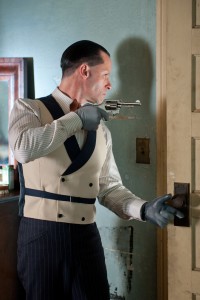
Guy Pearce gives Charlies Rakes a shot of eccentricity in "Lawless"
That’s the largest departure from the book is the characterization of Charlie Rakes. Charlie Rakes was a real guy, he was a real deputy, but he was a Franklin County resident. He did really want to kill my grandfather and his brothers for some reason. In the book I try to give a more complex, nuanced depiction of Charlie Rakes as a real person who had come to this point because of plausible scenarios that would cause these men to intersect in 1930 where he really wants to kill them. Hillcoat told me this was going to be a big departure and he ran it by me. But it was to sort of accentuate the outsider quality of Rakes to make him from Chicago, bring in somebody from the outside. It just helped translate him into a villain faster since there’s no backstory of Charlie Rakes in the film. He’s just a lunatic that shows up and is immediately crazy. I knot that Guy Pearce had a fair amount to do with the depiction and the way that he played him. And that’s what films have to do. The medium of film is limited in ways that novels are not, so that was the biggest departure.
The character of Maggie was the second one. In the film she’s from Chicago and in real life she was also a Virginia resident. But she was mysterious, she wore nice clothes and fancy dresses and things. We don’t even know the last name of the real Maggie. After Forrest died, they found out he was secretly married to her, and they lived a strange life. They lived together at the service station and they never had any children.
How did you go about doing most of your research, aside from going off the stories of your relatives?
A couple of the articles about these incidents are kind of helpful because they talk about Jack Bondurant saying things to the deputy and stuff like that. But a big part of the character stuff came from photos. There’s only two or three of my grandfather from this period and in all of them he’s sitting on top of his car wearing these nice clothes with a cigar in his mouth and his hat cocked, really trying to look tough. And I depicted those scenes in the book. Same thing with Bertha, my grandmother. So, Jack was clearly someone who wanted to have some flash and wanted to look like a character or gangster, to some degree. Also, the court transcripts from the Moonshine Conspiracy Trial of 1935 relate some of these incidents, like the shooting at Maggodee Creek and other run-ins between deputies like Charlie Rakes and the brothers. So we had lines where we’d hear things that they said, which are in the book and the film. They had a reputation and he clearly had a thing against them. Forrest supposedly had his throat cut and walked nine miles to the hospital, which is a pretty sketchy story. So I came up with the plausible explanation for that was that Maggie was there, and they play that pretty straight in the film to the way I wrote it. We also know that he … lived through all these things, so he’s kind of like this Rasputin figure because you couldn’t kill him.
My dad says he remembers Forrest as this tough character and nobody wanted to mess with him, but they don’t seem like the type of guys who were running around slapping people around in order to scare them. So why were they scared of them? They were scared of them because you couldn’t seem to kill this guy, Forrest. The film really took this and jacked this up, it’s one of the principal elements, this immortal thing. It’s natural that this is what made them scary … and Forrest understands this to some degree.
How does your father feel about the way his father has been characterized in the book and the film?
He seemed to like the book. He was a little concerned about the violence. He and my mother hadn’t seen a film in 30 years, so they were a little bit shocked. The only thing he feels strange about is having his mother portrayed in the midst of this bloodiness, even though the real Bertha Minnix married a known criminal. My father’s not a particularly talkative individual, so it’s hard to get much of a complex response out of him. I know he’s really proud of what I’ve accomplished, and of the notoriety, to some degree, of his family being known now. He’s 80 years old and I think he’s proud that our family has some sort of pointed history, even it is a little bit negative.
Lawless. Directed by John Hillcoat. Starring Shia LaBeouf, Tom Hardy, Gary Oldman, Mia Wasikowska, Jessica Chastain, Jason Clarke and Guy Pearce. Rated R. www.lawless-film.com.
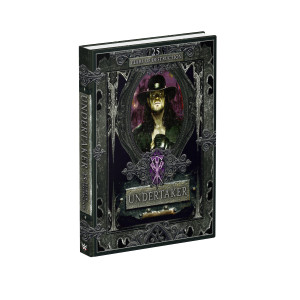 Written by longtime WWE scribe Kevin Sullivan (ironically not the same Kevin Sullivan that had a dark demeanor similar to the Undertaker’s in World Championship Wrestling), this book is a beautifully-presented collection of images and text that offers an encyclopedic look at the Undertaker’s ominously illustrious career. Beginning with his 1990 debut as part of Ted DiBiase‘s Million Dollar Team and concluding with his WrestleMania 31 victory over Bray Wyatt, 25 Years of Destruction spans the Deadman’s evolution in great detail. More than just a beginning-to-end timeline (though it does include a few of those), this book chronicles the Undertaker’s numerous championship achievements, his greatest in-ring rivalries, his unstable relationships with various managers and tag team partners, and his amazing accomplishments in brutal stipulation matches and pay-per-view encounters.
Written by longtime WWE scribe Kevin Sullivan (ironically not the same Kevin Sullivan that had a dark demeanor similar to the Undertaker’s in World Championship Wrestling), this book is a beautifully-presented collection of images and text that offers an encyclopedic look at the Undertaker’s ominously illustrious career. Beginning with his 1990 debut as part of Ted DiBiase‘s Million Dollar Team and concluding with his WrestleMania 31 victory over Bray Wyatt, 25 Years of Destruction spans the Deadman’s evolution in great detail. More than just a beginning-to-end timeline (though it does include a few of those), this book chronicles the Undertaker’s numerous championship achievements, his greatest in-ring rivalries, his unstable relationships with various managers and tag team partners, and his amazing accomplishments in brutal stipulation matches and pay-per-view encounters.
